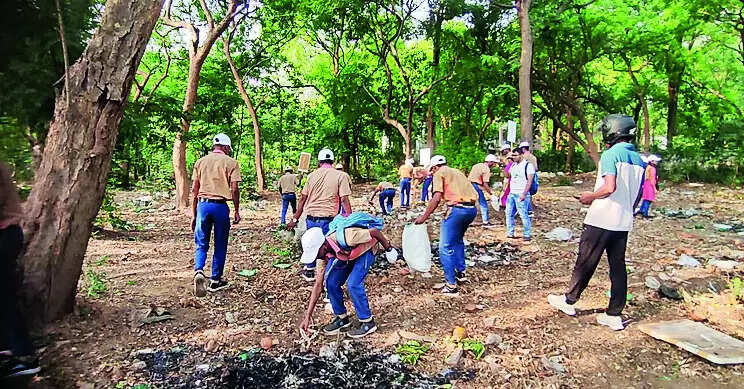Soil Degradation: ‘30% Of Soil Degraded Due To Erosion, Salinisation’ | Bhubaneswar News

Bhubaneswar: Around 30% of soil in Odisha is degraded due to various factors such as erosion, salinisation and nutrient depletion, affecting 5.4 million hectares of land, revealed a comprehensive survey conducted by voluntary organisation SwitchOn Foundation. As per the survey, this is a significant concern as it can have a detrimental impact on agriculture and food security in the state.Moreover, Odisha is facing multiple challenges related to land use and management, it revealed.
The report highlights that there has been significant deforestation between 2017 and 2023, with a 9% reduction in forest cover. At the same time, there has been a 37.6% increase in built-up areas, indicating rapid urbanisation.
The survey also shed light on the situation of groundwater in Odisha. It found that groundwater level remains a concern, particularly in semi-critical areas like Khurda and Bhubaneswar, where extraction rates are high due to domestic demands.
The Central Ground Water Board has identified several blocks as semi-critical, including Bolagarh, Talcher, Baliapal, Korei, Jharsuguda, Nayagarh, and Nuapada, where the extraction of groundwater is very high. In 2017, the average annual groundwater extraction was 6.5 billion cubic metres (BCM), which has increased to 6.8 BCM in 2020, 7.23 BCM in 2022 and 7.39 BCM in 2023.
Furthermore, the state has experienced a four-fold increase in drought occurrences over the past decade, which has worsened agricultural distress, rural unemployment and ecological issues such as temperature rise and wetland degradation, it said.
In 2021, Odisha faced one of the worst cases of drought in 20 years. The study also revealed that capital Bhubaneswar experiences mean maximum temperatures of around 42°C on an average during summer, similar to the interior region of Sambalpur.
Vinay Jaju, managing director of the foundation, said that the findings of the latest report are a stark reminder of the urgent need for sustainable practices and land restoration efforts in Odisha. “With 30% of our soil degraded and groundwater levels declining at an alarming rate, it is imperative that we take immediate action. Our initiatives, ranging from waste management drives to regenerative agriculture training are designed to tackle these challenges head-on,” he added.
To address these issues, SwitchOn has suggested that the state should promote regenerative agriculture, utilise AI in smart farming, preserve the soil, protect pollinators, revitalize freshwater ecosystems, renew coastal belts, and reintroduce nature to urban spaces.
The report highlights that there has been significant deforestation between 2017 and 2023, with a 9% reduction in forest cover. At the same time, there has been a 37.6% increase in built-up areas, indicating rapid urbanisation.
The survey also shed light on the situation of groundwater in Odisha. It found that groundwater level remains a concern, particularly in semi-critical areas like Khurda and Bhubaneswar, where extraction rates are high due to domestic demands.
The Central Ground Water Board has identified several blocks as semi-critical, including Bolagarh, Talcher, Baliapal, Korei, Jharsuguda, Nayagarh, and Nuapada, where the extraction of groundwater is very high. In 2017, the average annual groundwater extraction was 6.5 billion cubic metres (BCM), which has increased to 6.8 BCM in 2020, 7.23 BCM in 2022 and 7.39 BCM in 2023.
Furthermore, the state has experienced a four-fold increase in drought occurrences over the past decade, which has worsened agricultural distress, rural unemployment and ecological issues such as temperature rise and wetland degradation, it said.
In 2021, Odisha faced one of the worst cases of drought in 20 years. The study also revealed that capital Bhubaneswar experiences mean maximum temperatures of around 42°C on an average during summer, similar to the interior region of Sambalpur.
Vinay Jaju, managing director of the foundation, said that the findings of the latest report are a stark reminder of the urgent need for sustainable practices and land restoration efforts in Odisha. “With 30% of our soil degraded and groundwater levels declining at an alarming rate, it is imperative that we take immediate action. Our initiatives, ranging from waste management drives to regenerative agriculture training are designed to tackle these challenges head-on,” he added.
To address these issues, SwitchOn has suggested that the state should promote regenerative agriculture, utilise AI in smart farming, preserve the soil, protect pollinators, revitalize freshwater ecosystems, renew coastal belts, and reintroduce nature to urban spaces.
We also published the following articles recently
Results delayed due to agricultural practicals: KEA ED
KEA Executive Director Prasanna H clarified the CET delay was due to agriculture practical exams for BSc agriculture quota students, with results announced a day after the exams on May 31. He addressed media after Karnataka CET agricultural quota exams, with TOI reporting a record high of 3.1 lakh students attempting the CET this year.
KEA Executive Director Prasanna H clarified the CET delay was due to agriculture practical exams for BSc agriculture quota students, with results announced a day after the exams on May 31. He addressed media after Karnataka CET agricultural quota exams, with TOI reporting a record high of 3.1 lakh students attempting the CET this year.
















